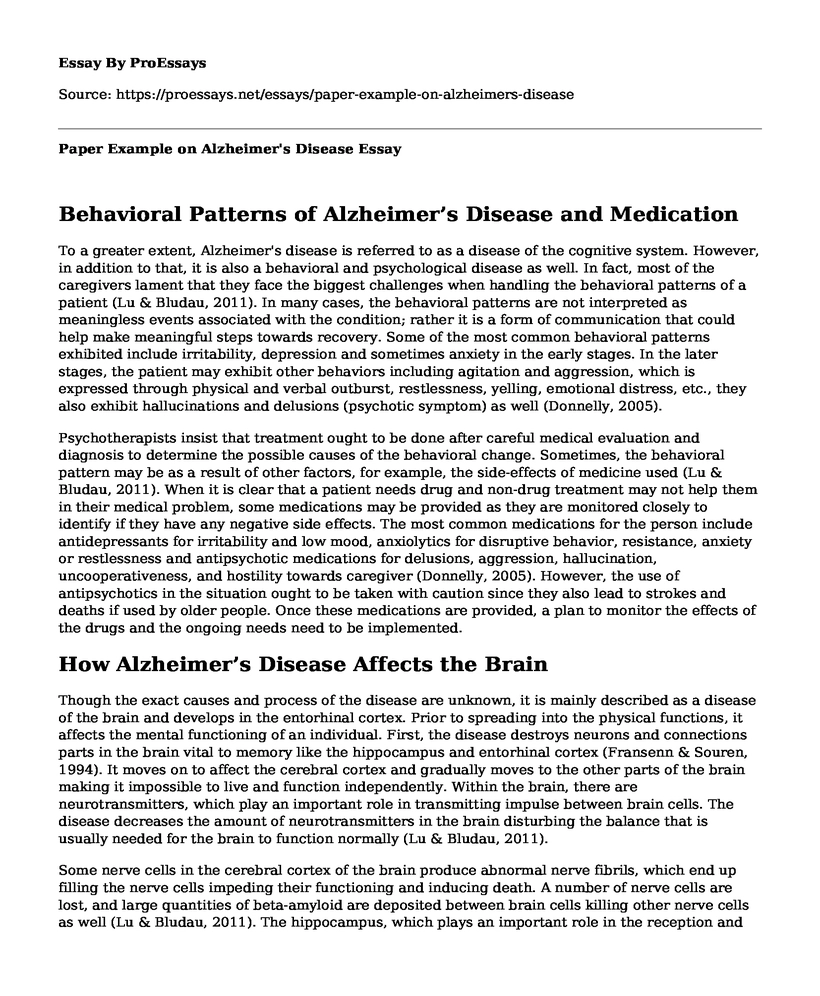Behavioral Patterns of Alzheimer’s Disease and Medication
To a greater extent, Alzheimer's disease is referred to as a disease of the cognitive system. However, in addition to that, it is also a behavioral and psychological disease as well. In fact, most of the caregivers lament that they face the biggest challenges when handling the behavioral patterns of a patient (Lu & Bludau, 2011). In many cases, the behavioral patterns are not interpreted as meaningless events associated with the condition; rather it is a form of communication that could help make meaningful steps towards recovery. Some of the most common behavioral patterns exhibited include irritability, depression and sometimes anxiety in the early stages. In the later stages, the patient may exhibit other behaviors including agitation and aggression, which is expressed through physical and verbal outburst, restlessness, yelling, emotional distress, etc., they also exhibit hallucinations and delusions (psychotic symptom) as well (Donnelly, 2005).
Psychotherapists insist that treatment ought to be done after careful medical evaluation and diagnosis to determine the possible causes of the behavioral change. Sometimes, the behavioral pattern may be as a result of other factors, for example, the side-effects of medicine used (Lu & Bludau, 2011). When it is clear that a patient needs drug and non-drug treatment may not help them in their medical problem, some medications may be provided as they are monitored closely to identify if they have any negative side effects. The most common medications for the person include antidepressants for irritability and low mood, anxiolytics for disruptive behavior, resistance, anxiety or restlessness and antipsychotic medications for delusions, aggression, hallucination, uncooperativeness, and hostility towards caregiver (Donnelly, 2005). However, the use of antipsychotics in the situation ought to be taken with caution since they also lead to strokes and deaths if used by older people. Once these medications are provided, a plan to monitor the effects of the drugs and the ongoing needs need to be implemented.
How Alzheimer’s Disease Affects the Brain
Though the exact causes and process of the disease are unknown, it is mainly described as a disease of the brain and develops in the entorhinal cortex. Prior to spreading into the physical functions, it affects the mental functioning of an individual. First, the disease destroys neurons and connections parts in the brain vital to memory like the hippocampus and entorhinal cortex (Fransenn & Souren, 1994). It moves on to affect the cerebral cortex and gradually moves to the other parts of the brain making it impossible to live and function independently. Within the brain, there are neurotransmitters, which play an important role in transmitting impulse between brain cells. The disease decreases the amount of neurotransmitters in the brain disturbing the balance that is usually needed for the brain to function normally (Lu & Bludau, 2011).
Some nerve cells in the cerebral cortex of the brain produce abnormal nerve fibrils, which end up filling the nerve cells impeding their functioning and inducing death. A number of nerve cells are lost, and large quantities of beta-amyloid are deposited between brain cells killing other nerve cells as well (Lu & Bludau, 2011). The hippocampus, which plays an important role in the reception and processing of new information, is affected negatively by the multiplication of the plaques and tangles throughout the brain. As Functioning in the brain that requires the collaboration of nerve cells are soon affected by the condition, for example, speech is soon impeded as the other brain functions are also affected gradually (Lu & Bludau, 2011). As the brain cells continue dying off, the brain's mass continues reducing gradually, and the functioning of the individual is made impossible.
References
Donnelly, M. L. (2005). Behavioral and psychological disturbances in Alzheimer disease: Assessment and treatment. dementia, 32, 3.
Franssen, E., & Souren, L. (1994). Broken connections: Alzheimer's disease. Boca Raton, Florida: CRC Press.
Lu, L. & Bludau, J. (2011). Alzheimer's Disease. Santa Barbara, CA: ABC-CLIO.
Cite this page
Paper Example on Alzheimer's Disease. (2022, Apr 07). Retrieved from https://proessays.net/essays/paper-example-on-alzheimers-disease
If you are the original author of this essay and no longer wish to have it published on the ProEssays website, please click below to request its removal:
- Intervention Planning for Adolescents and Sedentary Behaviour/Physical Activity in Australia
- Essay Example on Pneumonia: A Respiratory Disease Killing Children Under 5
- Stay Hydrated: Essay Sample on The Benefits of Drinking Water for Your Health
- Article Analysis Essay on Wastewater Reuse for Irrigation: Nutrient Recovery & Waste Disposal
- Conquering Smoking Addiction: Steps for Mitigation & Better Decision Making - Essay Sample
- Essay Example on Leukemia: A Deadly Blood Cancer Affecting All Ages
- Nurse Self-Growth: Achieving the Best Self for Quality Care - Essay Sample







